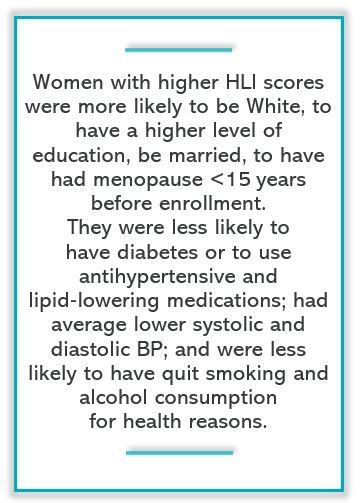- Clinical Technology
- Adult Immunization
- Hepatology
- Pediatric Immunization
- Screening
- Psychiatry
- Allergy
- Women's Health
- Cardiology
- Pediatrics
- Dermatology
- Endocrinology
- Pain Management
- Gastroenterology
- Infectious Disease
- Obesity Medicine
- Rheumatology
- Nephrology
- Neurology
- Pulmonology
Healthy Lifestyle Linked to Primary CVD Prevention in Postmenopausal Women with Normal BMI
Among postmenopausal women with normal body mass index (BMI) and without history of cardiovascular disease (CVD), maintaining a healthy lifestyle based on diet, physical activity, and other modifiable behavioral risk factors, was significantly associated with reduced risk of a first CVD event over a follow-up period of 20 years, according to new research published in the Journal of the American Heart Association.
©Monkey Business/stock.adobe.com

The study, based on a cohort of more than 40 000 women in the Women's Health Initiative (WHI; 1993-1998), suggests that following recommended lifestyle guidelines provides substantial CV benefits beyond control of body weight, with "healthy" weight widely understood as essential to reduce the risk of CVD-related morbidity and mortality.
“Several studies have shown that a relatively high healthy lifestyle index, which reflects a high-quality diet, moderate to high physical activity, low alcohol consumption, a relatively small waist circumference, and no cigarette smoking, is associated with reduced risk of CVD,” Rita Peila, PhD, of the department of epidemiology and population health at the Albert Einstein College of Medicine in New York, and colleagues wrote.
“Although previous studies have examined the association of individual behavioral factors, such as a sedentary lifestyle, with CVD risk among women with a normal BMI, none has examined whether a combination of these factors, as reflected in a higher healthy lifestyle index, is associated with reduced risk of CVD among individuals with a normal BMI.”
To accomplish the assessment, Peila and her team created a healthy lifestyle index (HLI) based on 5 lifestyle-related factors: waist circumference, cigarette smoking, alcohol intake, diet quality, and leisure‐time physical activity. A score (0–4) was assigned to individual categories of each lifestyle component, with higher scores reflecting healthier behaviors. The scores for each factor were summed to generate a composite HLI score (0–20), again with higher scores indicating healthy regimens.
Participant data was drawn from the WHI with the final cohort for analysis comprised of 40 118 women aged 40-59 years with BMI between 18.5 and 25.0 kg/m2 and without history of CVD. Participants were subsequently stratified by quintiles of calculated HLI scores.
The primary outcome was the first occurrence of CVD which included stroke, CHD, angina requiring hospitalization, and coronary revascularization procedures, as defined in the WHI.
FINDINGS
Peila et al reported that during a median follow-up of 20.1 years, there were 3821 documented cases of a first CVD event. They found that women in the higher quintiles of HLI scores compared to those in lowest quintiles were at lower risk for incident CVD overall with hazard ratios (HR) as follows: quintile 2, HR 0.74; 95% CI, 0.67-0.81; quintile 3, HR 0.66; 95% CI, 0.6-0.72; quintile 4, HR 0.57; 95% CI, 0.51-0.63; quintile 5, HR 0.48; 95% CI, 0.43-0.54 (P for trend <.001).

They also reported an inverse association between HLI and risks of CVD components -- stroke, CHD, MI, angina, and coronary revascularization. Further, the inverse association between HLI score and risk of CVD remained significant across subgroup analyses, stratified by age (≤63 years vs >63 years), BMI (/≥ 22.0 kg/m2), and general health status, eg, absence/presence of hypertension, diabetes, or lipid‐lowering drug use.
In separate analyses excluding 1 HLI component at a time from the overall HLI score, the researchers reported no change in the relationship between a healthy lifestyle and CVD, “suggesting that no specific behavioral habit alone was responsible for the observed association," they wrote.
As the prevalence of overweight and obesity climb steadily worldwide, public health recommendations focus on lifestyle change targeting weight loss or weight maintenance in a “healthy” range. Acknowledging this imperative, Peila and colleagues point to their findings that suggest lifestyle modification to reduce CVD risk may be important even when BMI is normal.
“Indeed, we found that compared with those with the lowest level of HLI, even those with intermediate HLI scores, resulting from various levels of adherence to different lifestyle behaviors, have a lower CVD risk," stated Peira et al. "This trend was present in various subgroups of postmenopausal women, independently of their BMI, age, or health status, despite the different baseline risks of the referent categories, as indicated by the reported incidence rates."
As a major limitation of the study, the investigators note the absence of information on participant lifestyle changes during the 2-decade follow-up that may have affected the associations observed.
Reference: Peila R, Xue X, Qi Q, et al. Healthy lifestyle index and risk of cardiovascular disease among postmenopausal women with normal body mass index. J Am Heart Assoc. 2023;12. Published online June 12,2023. doi: 10.1161/JAHA.122.029111
